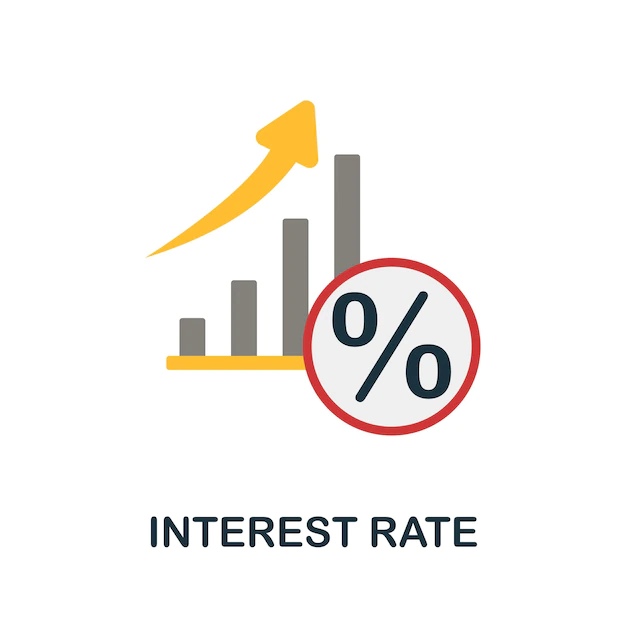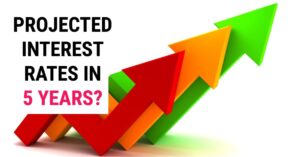It's always important to stay on top of financial trends, especially when it comes to interest rates. Are you also wondering what the projected interest rates will be in the next five years? Understanding the future of interest rates can help you make informed decisions when it comes to investments, mortgages, and other financial choices. Unless you have a crystal ball that can predict the future, it's impossible to know how much interest rates will rise in the coming five years.
Projected Interest Rates in 5 Years
Pent-up demand, especially for travel, means inadequate supply to chains still rocked by COVID-19, but Russia's invasion of Ukraine and energy insecurity have raised oil and gas prices. It implies central bankers are uncertain how successful monetary tightening will be against many mitigating factors, with rate rises potentially adding pain without resolving rising prices. Interest rates are projected to rise in the near term as policymakers try to ward off 40-year-high inflation, but they are expected to peak soon thanks to expectations of a recession in the US.
The Global Economic Landscape: The OECD Economic Outlook for 2024 reflects a mixed scenario. Despite a robust start to 2023, fueled by lower energy prices and the reopening of the Chinese economy, global growth is expected to moderate. Tighter monetary policies are impacting business and consumer confidence, leading to a projected global GDP growth of 2.7% in 2024.
The United States and the euro area are anticipated to experience slowdowns, while China faces challenges from subdued domestic demand and structural stresses. Inflation trends show a decline in headline inflation but persistent core inflation, influenced by cost pressures and high margins in certain sectors.
Policy Recommendations and Challenges: The report highlights downside risks, including uncertainty in monetary policy transmission, inflation persistence, and potential adverse effects of higher interest rates. Governments are urged to address fiscal pressures through near-term efforts to rebuild fiscal space and credible medium-term fiscal plans.
Structural reforms are recommended to strengthen growth prospects, focusing on reducing barriers in labor and product markets and enhancing skills development. Additionally, reviving global trade and fostering international cooperation for carbon mitigation are emphasized as key priorities for long-term prosperity and sustainability.
Capital Economics predicted inflation to sit at 2.5% by the end of 2023, and between 2026 and 2031, while the CBO expected inflation to average 2.4% between 2028 and 2030.
Interest rates are a crucial factor in the financial markets that have wide-ranging ramifications for the economy. The US Federal Reserve (Fed) sets the Federal Funds Rate (FFR), which influences demand for bonds, prime rates, and the overall economy. Even slight variations in interest rates can have significant effects on the stock market and investment portfolios, affecting both buyers and sellers.
The Federal Reserve is responsible for setting the target range for the federal funds rate, which is the interest rate at which banks lend to each other overnight. This rate has a significant impact on the overall economy, influencing borrowing costs for individuals and businesses, as well as affecting the value of the dollar.
The predictions made by the various analysts and banks provide insight into what the financial markets anticipate for interest rates over the next few years. Based on recent data, Trading Economics predicts that rates will fall back down to 4.25% in 2024 and 3.25% in 2025. Morningstar analyst Preston Caldwell, on the other hand, is skeptical that the Fed will continue raising rates throughout 2023 and has predicted lower rates of 3.75%-4%.
ING predicts interest rates ranging between 3% and 4.25% in 2024, staying at 3% by the end of 2025. The differences in these forecasts may be attributed to the different methodologies and models used to generate them.
Also Read: Mortgage Interest Rates Forecast 2024
Factors That Could Influence Interest Rates in Five Years
The US, like other major Western economies, has enjoyed an unparalleled period of low price and interest rate volatility. The current bout of price rises means investors could need to reassess how they allocate their portfolios. The FFR was below 2% in the 1950s, amid postwar stimulus and income growth across the US. The rate saw-sawed over a 20-year period, rising and falling between 3% and 10% during the 1960s and 1970s before skyrocketing inflation that exceeded 13% in 1980 forced rates to a record high of 19.1%.
As inflation was brought under control, the FFR hovered around 5% through the 90s, before recessions in 2001 and 2008 forced them down to a floor, keeping rates low until 2016. The COVID-19 pandemic imposed another cut to almost 0%, with recent inflationary pressures forcing the Fed to begin tightening policy. The Fed increased rates seven times in 2022 and by another 25 bps in February 2023, bringing it to 4.5%-4.75%, the highest since the aftermath of the 2007-2008 financial crisis.
Throughout the year 2023, the Federal Reserve (often referred to as the Fed) implemented a series of interest rate hikes in an effort to manage economic conditions, curb inflation, and achieve its monetary policy goals. Let's break down the chronology of these rate hikes:
In March 2023, the Federal Reserve once again raised the interest rates by 25 basis points. The target range for the federal funds rate was increased from 4.75% to 5.00%. This rate hike was the second of the year and indicated the Fed's continued commitment to gradually tightening monetary policy.
In May 2023, in its third interest rate hike of the year, the Federal Reserve increased rates by another 25 basis points. The target range for the federal funds rate was elevated from 5.00% to 5.25%. This rate hike marked a consistent pattern of incremental adjustments to the interest rates, reflecting the Fed's cautious approach to managing economic conditions and inflation.
The last hike came in July when the Federal Reserve's decision to approve a long-anticipated interest rate hike sent ripples through the financial markets and garnered the attention of economists, investors, and consumers alike. In a move that was largely anticipated by the financial world, the Federal Open Market Committee (FOMC) announced a quarter-percentage-point increase in the benchmark borrowing costs, pushing the target range to 5.25%-5.5%. This adjustment marks a significant milestone as it takes the interest rates to their highest level in more than 22 years, raising important questions about its implications for the economy and various sectors.
This chronology of interest rate hikes in 2023 demonstrates the Federal Reserve's proactive stance in addressing economic developments and inflationary pressures. The sequence of rate hikes indicates the Fed's commitment to maintaining a balance between supporting economic growth and ensuring that inflation remains within its target range. These decisions were closely watched by financial markets, economists, and policymakers as they had implications for a wide range of economic factors, from consumer borrowing costs to investment decisions.
There are several key factors that could influence interest rates over the next five years. One major factor is inflation, which is currently at historic highs due to a mix of demand and supply factors. The Fed will need to monitor inflation closely and determine whether monetary tightening will be effective in addressing the underlying problem of high prices. In addition to inflation, the strength of the US dollar will also be a significant factor.
While the dollar has enjoyed resilience due to its status as a safe haven currency and the Fed's hawkish monetary policy, its strength has started to slow as monetary tightening has slowed. The possibility of a recession also looms large over interest rate predictions. While the US experienced a contraction in GDP in the second quarter of 2022, GDP has since rebounded. However, if a recession were to occur, the Fed may need to halt its regimen of rate hikes to avoid putting further strain on growth.
Finally, the specter of stagflation could also make policymakers' decisions even more difficult. Stagflation, which is a combination of stagnant economic growth and high inflation, could result in a complex policy response that could further impact interest rates. Overall, while interest rate predictions over the next five years may be subject to change based on a variety of factors, monitoring inflation, the strength of the US dollar, the possibility of a recession, and the potential for stagflation will all be key for policymakers and investors alike.
Mortgage Rate Predictions for Next 5 Years

If you're planning on mortgaging your home at least until age 55 and possibly beyond, you should start looking into how much interest rates are likely to go up in the coming decade. If you don't already understand how much interest rates affect your wallet, this article will explain everything you need to know about projected interest rates in the next five years and what that means for you as a borrower.
Mortgage interest rates determine the interest you pay on your home loan. When you get your house loan approved, the lender will usually project what interest rates are likely to be and then you can decide if you want to go with that interest rate or some other available option. But when you ask what is the interest rate, you're not just looking at what rate is listed on the contract, you're also taking into account what rate is likely to go up in the future and what will happen to rates if new laws are passed.
Mortgage interest rates follow the same pattern as the stock market does, with periods of high profitability followed by periods of low profitability. As was the case with stocks, homeowners who take out a mortgage are at a particular advantage, as they can lock in a higher rate of return by waiting until the market is profitable again. If the market performs poorly for a prolonged period of time, homeowners are stuck with high-interest rates. That's not good for you or your house price.
A number of factors can affect your mortgage interest rate, including the total amount of your mortgage loan, the mortgage terms, and the health of the housing market. According to algorithm-based forecasting service Longforecast's interest rate projections, from 2023 to July 2027, the 30 Year Mortgage Rate predictions show a notable decrease in mortgage rates.
The rates start at around 6.67% in June 2023 and gradually decline over the years. By July 2027, the rates have reached 3.11%. Throughout this period, there are fluctuations in rates, with some months experiencing slight increases and others seeing decreases.
However, the overall trend is a significant downward movement, with the total change ranging from -41.1% to -55.2%. These predictions suggest that borrowers may have the opportunity to secure lower mortgage rates during this timeframe, potentially benefiting homeowners and prospective buyers.
Projected Mortgage Interest Rate Forecast 2024
According to various sources, there are forecasts indicating that mortgage rates may pose affordability challenges for buyers in 2024. The National Association of Realtors anticipates a drop in interest rates to around 6% in 2024. Additionally, the Mortgage Bankers Association (MBA) predicts that the 30-year fixed rate will settle in the 5% range for the entire year of 2024.
The MBA revised its projections upwards in its August Mortgage Finance Forecast. Initially, it had expected the 30-year fixed rate to dip below 6% by the end of 2023. However, the industry group now suggests that the average rate will remain above the 6% mark until early 2024.
Furthermore, there is an expectation that the Federal Reserve will lower rates to reduce borrowing costs, likely in the first or second quarter of 2024. Nevertheless, rates are predicted to conclude the year somewhere in the range of 6.5% to 6.8%.
It's worth noting that predicting future mortgage rates is a challenging endeavor, as historical data has shown that mortgage rate forecasts can be highly uncertain.
According to Longforecast, the 30-year mortgage rates are predicted to fluctuate throughout 2024, with a starting range of 6.51%-7.14% in January. While experiencing minor monthly variations, rates are expected to close the year at 8.29%, reflecting an overall increase from the initial point.
The rates demonstrate a gradual upward trajectory, with notable increases in July (8.18%) and November (8.45%). However, some months, such as September, show a slight decrease (-5.0%), indicating potential variability in the mortgage rate landscape. Despite fluctuations, the year concludes with a 1.9% decrease in December, settling at 8.29%.
| Month | Low-High | Close | Mo,% | Total,% |
|---|---|---|---|---|
| January | 6.51-7.14 | 6.71 | -6.0% | -8.0% |
| February | 6.71-7.32 | 7.11 | 6.0% | -2.5% |
| March | 7.02-7.46 | 7.24 | 1.8% | -0.7% |
| April | 7.24-7.76 | 7.53 | 4.0% | 3.3% |
| May | 7.40-7.86 | 7.63 | 1.3% | 4.7% |
| June | 7.51-7.97 | 7.74 | 1.4% | 6.2% |
| July | 7.74-8.43 | 8.18 | 5.7% | 12.2% |
| August | 8.03-8.53 | 8.28 | 1.2% | 13.6% |
| September | 7.63-8.28 | 7.87 | -5.0% | 8.0% |
| October | 7.87-8.47 | 8.22 | 4.4% | 12.8% |
| November | 8.20-8.70 | 8.45 | 2.8% | 15.9% |
| December | 8.04-8.54 | 8.29 | -1.9% | 13.7% |
Projected Mortgage Interest Rate Forecast 2025
Overview: Predictions for 30-year mortgage rates in 2025 suggest a fluctuating pattern, starting at 7.66%-8.29% in January. Monthly variations are expected, culminating in a year-end rate of 6.54%, reflecting an overall decline from the initial point.
Key Observations: Notable monthly shifts, such as a 5.7% increase in March and a 6.0% decrease in May, indicate the responsiveness of mortgage rates. Despite periodic fluctuations, the year concludes with a 5.1% decrease in December, settling at 6.54%, potentially influencing the real estate landscape.
| Month | Low-High | Close | Mo,% | Total,% |
|---|---|---|---|---|
| January | 7.66-8.29 | 7.90 | -4.7% | 8.4% |
| February | 7.21-7.90 | 7.43 | -5.9% | 1.9% |
| March | 7.43-8.09 | 7.85 | 5.7% | 7.7% |
| April | 7.16-7.85 | 7.38 | -6.0% | 1.2% |
| May | 6.73-7.38 | 6.94 | -6.0% | -4.8% |
| June | 6.33-6.94 | 6.53 | -5.9% | -10.4% |
| July | 6.42-6.82 | 6.62 | 1.4% | -9.2% |
| August | 6.33-6.73 | 6.53 | -1.4% | -10.4% |
| September | 6.53-7.13 | 6.92 | 6.0% | -5.1% |
| October | 6.31-6.92 | 6.50 | -6.1% | -10.8% |
| November | 6.50-7.10 | 6.89 | 6.0% | -5.5% |
| December | 6.34-6.89 | 6.54 | -5.1% | -10.3% |
Projected Mortgage Interest Rate Forecast 2026
Overview: Projections for 30-year mortgage rates in 2026 indicate a downward trend, starting at 5.97%-6.54% in January. Monthly decreases are expected, resulting in a year-end rate of 5.77%, reflecting a substantial overall decline from the initial point.
Key Trends: Notable monthly reductions, such as a 4.9% decrease in December, emphasize the consistent downward trajectory of mortgage rates. The year concludes with a 20.9% reduction from the initial point in January, potentially shaping a favorable environment for homebuyers and the real estate market.
| Month | Low-High | Close | Mo,% | Total,% |
|---|---|---|---|---|
| January | 5.97-6.54 | 6.15 | -6.0% | -15.6% |
| February | 5.87-6.23 | 6.05 | -1.6% | -17.0% |
| March | 5.79-6.15 | 5.97 | -1.3% | -18.1% |
| April | 5.97-6.42 | 6.23 | 4.4% | -14.5% |
| May | 6.23-6.73 | 6.53 | 4.8% | -10.4% |
| June | 6.53-6.97 | 6.77 | 3.7% | -7.1% |
| July | 6.28-6.77 | 6.47 | -4.4% | -11.2% |
| August | 6.15-6.53 | 6.34 | -2.0% | -13.0% |
| September | 6.19-6.57 | 6.38 | 0.6% | -12.5% |
| October | 5.98-6.38 | 6.17 | -3.3% | -15.4% |
| November | 5.89-6.25 | 6.07 | -1.6% | -16.7% |
| December | 5.60-6.07 | 5.77 | -4.9% | -20.9% |
Projected Mortgage Interest Rate Forecast 2027
Overview: Predictions for 30-year mortgage rates in 2027 reveal a consistent downward trajectory, commencing at 5.67%-6.03% in January. Monthly reductions are expected, culminating in a year-end rate of 4.84%, showcasing a substantial overall decline from the initial point.
Key Observations: Notable monthly decreases, including a 6.0% reduction in August and a 3.4% decrease in September, underscore the sustained downward trend of mortgage rates. The year concludes with a 33.6% reduction from the initial point in January, potentially shaping a favorable landscape for prospective homebuyers and the real estate market.
| Month | Low-High | Close | Mo,% | Total,% |
|---|---|---|---|---|
| January | 5.67-6.03 | 5.85 | 1.4% | -19.8% |
| February | 5.85-6.27 | 6.09 | 4.1% | -16.5% |
| March | 5.78-6.14 | 5.96 | -2.1% | -18.2% |
| April | 5.60-5.96 | 5.77 | -3.2% | -20.9% |
| May | 5.46-5.80 | 5.63 | -2.4% | -22.8% |
| June | 5.36-5.70 | 5.53 | -1.8% | -24.1% |
| July | 5.46-5.80 | 5.63 | 1.8% | -22.8% |
| August | 5.13-5.63 | 5.29 | -6.0% | -27.4% |
| September | 4.96-5.29 | 5.11 | -3.4% | -29.9% |
| October | 4.83-5.13 | 4.98 | -2.5% | -31.7% |
| November | 4.73-5.03 | 4.88 | -2.0% | -33.1% |
| December | 4.69-4.99 | 4.84 | -0.8% | -33.6% |
It should be noted that analysts' and algorithm-based projections can be incorrect. Interest rate estimates should not be utilized in place of your own study. Always conduct your own research. Furthermore, never invest or trade money that you cannot afford to lose.
Why Should You Care About Projection of Interest Rates?
The higher the interest rate, the less attractive the opportunity to borrow money at that rate is for you as a homebuyer. As a result, it could make more sense to borrow at a lower rate, especially if you have a modest amount to spend on a home and are looking for a low-interest loan. If you are running behind on payments and have a limited amount of equity, a higher interest rate could make you borrow money from your workers' compensation fund or a government program that provides short-term loans.
It could also mean higher insurance costs or a higher cost of living once you move in. If you have money to invest and would instead put that money in something that earns more interest than a mortgage, you should know that rates on savings accounts and mutual funds are likely to go up as well, not down.
Interest Rates and Their Role in Financial Markets
The Fed sets the FFR, the base interest rate that filters through to banks, affecting demand for bonds and more broadly the economy and stocks. The process begins when the Fed sets the FFR at the Federal Open Market Committee (FOMC) meeting, eight of which occur every year. Those decisions filter through to the prime rate, the basic interest rate banks charge to credit-worthy customers. A hike in the FFR will see the base prime rate rise, affecting the cost of loans and mortgages.
The rising cost of servicing loans takes more discretionary income out of consumers and businesses, reducing demand and reigning in price increases. For stocks, that could mean companies and stocks dependent on consumer spending, like the retail and hospitality sectors, face headwinds. Growth stocks, which rely on lending and capital, could also suffer as investors look for value in profitable companies to ride out market volatility and a downturn.
Mechanically, interest rate rises also hit the value of bonds. When interest rates rise, the yield on a bond becomes less valuable, as it garners less interest than the prevailing base rate, forcing a sell-off. This is particularly true for longer-term interest rates, as the discrepancy is magnified over time. Likewise, fixed-income securities lose their value with rises as the cost of not owning other interest-rate tracking assets increases.
How Much Interest Will You Pay?
This is one of the most important factors to keep in mind when you're looking at projected interest rates. It is not just the price of the mortgage that is important – it is the interest rate you pay on every dollar you borrow. If you are refinancing an existing loan, the amount you will be paying will depend on your current interest rate and the total amount of your loan. If you are buying a new house, your interest rate will be lower than if you are refinancing an existing home as that is the type of loan we refer to as a ” cash-out refinance.”
What Are Other Factors That Affect Your Payment?
When you compare interest rates for different cities, you are ignoring other factors that could affect your monthly payment. For example, if you are refinancing an existing loan and are in a city where house prices are low, you will pay less interest than if you were in a city where house prices are higher. These other factors can include taxes, insurance, building costs, and utilities.
In summary, when it comes to the future of mortgage interest, we don't know exactly what will happen. That is why it is important to get a feel for what the projected rates are so you can plan ahead and decide if any of these rates are right for you and your financial situation. If you are currently working with a lender and are interested in switching providers, you should know that most lenders are required to give you 30 days' notice before changing rates. Even then, you will only be given a 25% discount on the new rate if you want it.
Sources:
- https://data.oecd.org/price/inflation-forecast.htm
- https://capital.com/projected-interest-rates-in-5-years
- https://longforecast.com/mortgage-interest-rates-forecast-2017-2018-2019-2020-2021-30-year-15-year
- https://www.noradarealestate.com/blog/mortgage-interest-rates-forecast/





 Long-term mortgage rates continued to move lower this week, with a 15-year fixed-rate mortgage falling to a record low for the second consecutive week.
Long-term mortgage rates continued to move lower this week, with a 15-year fixed-rate mortgage falling to a record low for the second consecutive week. I just locked down a 2.875% interest rate, fixed for the 15-year term of the mortgage. No points. With rates like these, I find myself rethinking the idea that I want to pay off my mortgage.
I just locked down a 2.875% interest rate, fixed for the 15-year term of the mortgage. No points. With rates like these, I find myself rethinking the idea that I want to pay off my mortgage. So far, I’ve never heard the same commotion in the market and the media unlike earlier this year when the US economy earned an embarrassing downgrade.
So far, I’ve never heard the same commotion in the market and the media unlike earlier this year when the US economy earned an embarrassing downgrade. On November 19, 2009 Freddie Mac recorded an average 30 year mortgage rate at 4.83%, down from 4.91% the previous week. Just over one year ago, the 30 year mortgage rate averaged 6.04%. So long as you have solid credit and a 20% down payment, whether
On November 19, 2009 Freddie Mac recorded an average 30 year mortgage rate at 4.83%, down from 4.91% the previous week. Just over one year ago, the 30 year mortgage rate averaged 6.04%. So long as you have solid credit and a 20% down payment, whether 